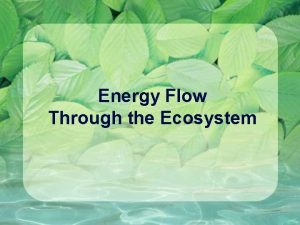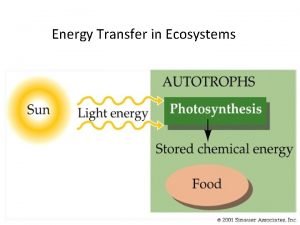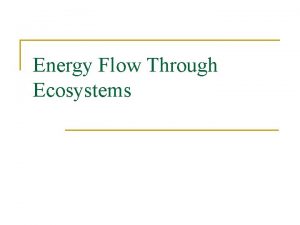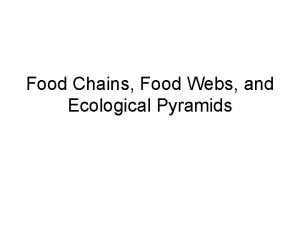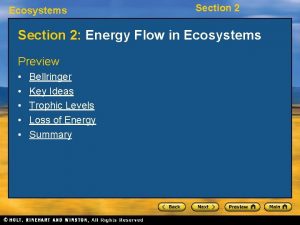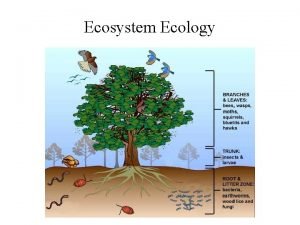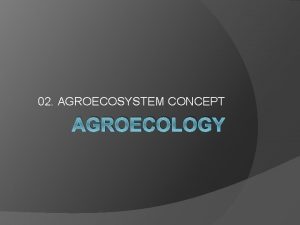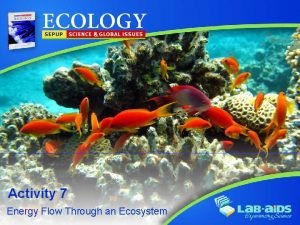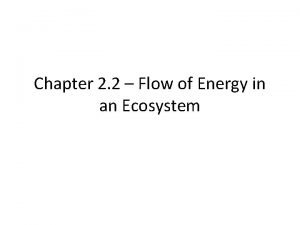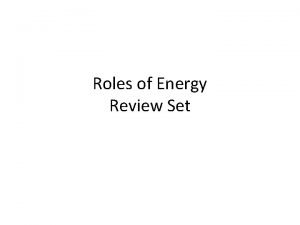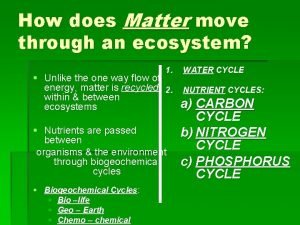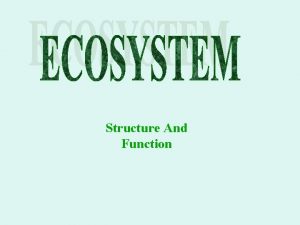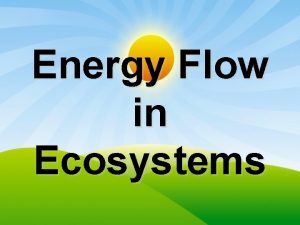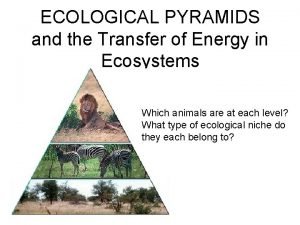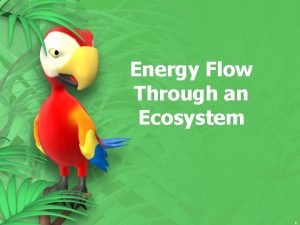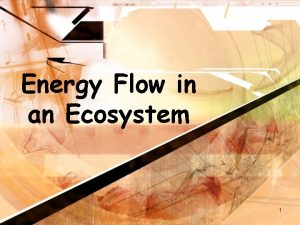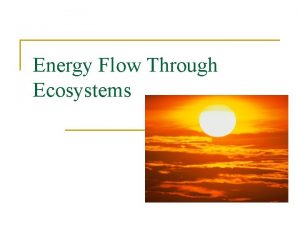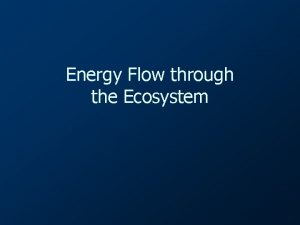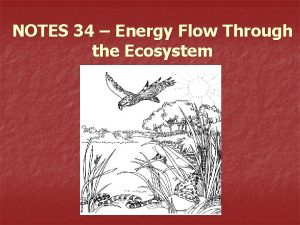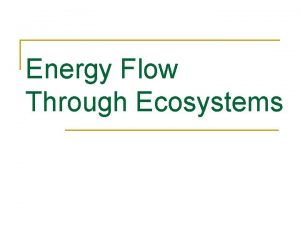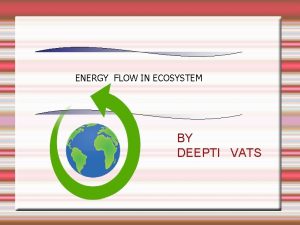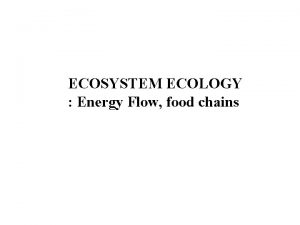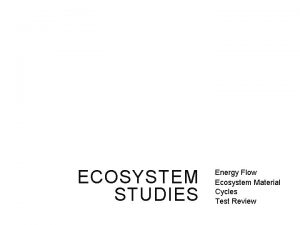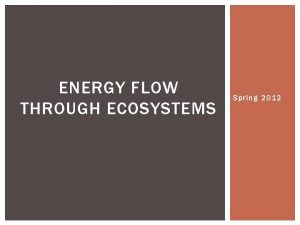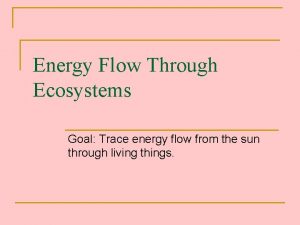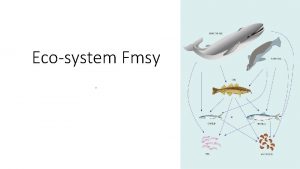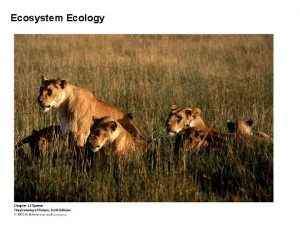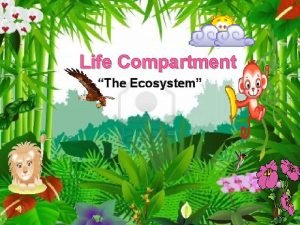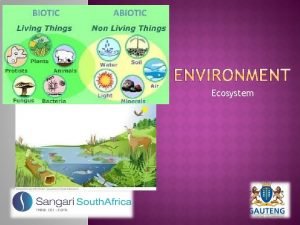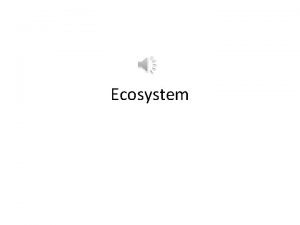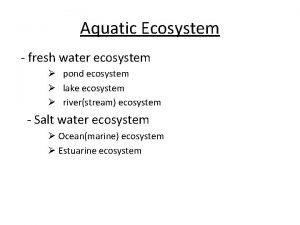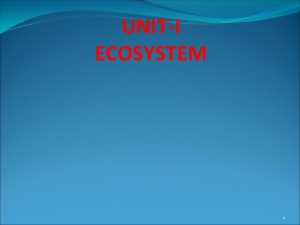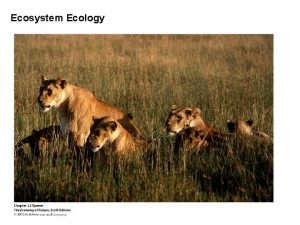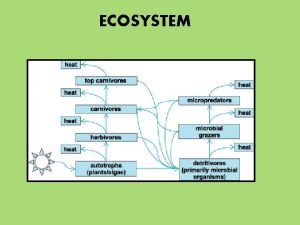Activity 7 Energy Flow Through an Ecosystem Get































- Slides: 31

Activity 7 Energy Flow Through an Ecosystem

Get Started Organisms in an Ecosystem � As you view the diagram on the next slide… � Identify which organisms are PRODUCERS and which are CONSUMERS � What are some different types of consumers? � What relationships do you observe? � How does energy flow through these organisms Activity 7: Energy Flow Through an Ecosystem

Get Started Activity 7: Energy Flow Through an Ecosystem

Get Started Activity 7: Energy Flow Through an Ecosystem

FOOD CHAIN: shows the flow of energy through a series of organisms Activity 7: Energy Flow Through an Ecosystem

Activity 7: Energy Flow Through an Ecosystem

Get Started Activity 7: Energy Flow Through an Ecosystem

Introduction Read the Introduction � What is kelp? � To what land biome do kelp forests compare? � What is a food web? � What are decomposers? Activity 7: Energy Flow Through an Ecosystem

Challenge � How can we use food webs to predict the short- and long-term effects of particular events on an ecosystem? Activity 7: Energy Flow Through an Ecosystem

Procedure Roles of organisms in Ecosystems � Separate the organism cards into 2 or more groups. � Record your responses in your notebook Activity 7: Energy Flow Through an Ecosystem

FOOD WEB Activity 7: Energy Flow Through an Ecosystem

Food Web - Interconnected Food Chain. • The arrow in a food web always points toward the consumer in the direction of the flow of energy TROPHIC LEVELS: Tertiary Consumer – Hawk Secondary Consumer – Bird Primary Consumer – grasshopper Producer - Grass Activity 7: Energy Flow Through an Ecosystem .

TROPHIC LEVELS Activity 7: Energy Flow Through an Ecosystem

Procedure Create a Food Web � Start with the kelp card � Place other producers on either side � Build from the producers to the primary consumers…then to the secondary consumers…and so on � Once you have built your food web…draw it on chart paper � Be sure ARROWS point in the right direction to show flow of energy Activity 7: Energy Flow Through an Ecosystem

Introduction FOOD CHAIN Activity 7: Energy Flow Through an Ecosystem

Follow Up � Which level in the energy pyramid contains the most energy? � What happens to energy as it flows through the ecosystem? � Why is there a different amount of energy available to the producers than to the tertiary consumers? What happened to the energy? Activity 7: Energy Flow Through an Ecosystem

Procedure � Now use different colors to color code each trophic level in your food web � Can an organism occupy more than one trophic level? � Give an example from your food web Activity 7: Energy Flow Through an Ecosystem

Procedure IMPACT OF EVENTS/ACTIONS ON ECOSYSTEMS � Go through the event cards…one at a time � Summarize the event in the table � Predict short term and long term effects Activity 7: Energy Flow Through an Ecosystem

Introduction ENERGY PYRAMIDS Activity 7: Energy Flow Through an Ecosystem

Introduction Ecological Pyramid – shows the amount of energy or matter contained within each trophic level. Pyramids (Diagrams) that show the transfer of: • Energy • Biomass – amount of living matter at each trophic level • Population Size – relative # of organisms at each trophic level Activity 7: Energy Flow Through an Ecosystem

SUN Scavengers, decomposers Only 10 percent of energy goes to the next level. The rest is either used or lost as heat. As move up the pyramid energy is lost so the amount of energy decreases. Energy must be replaced by the sun. 4 th trophic level 3 rd heterotroph (3 rd consumer) Carnivore- eats meat 3 rd trophic level 2 nd heterotroph (2 nd consumer) Carnivore- eats herbivore 2 nd trophic level 1 st heterotroph (1 st consumer) Herbivore- eats plants 1 st trophic level. Autotroph- plant. Activity 7: Energy Flow Through an. Producer. Ecosystem Trophic Level = Energy Level.

Procedure ENERGY PYRAMID � Complete an Energy Pyramid for your marine kelp food web Activity 7: Energy Flow Through an Ecosystem

Follow Up ANALYSIS � Answer questions 1 -7 Activity 7: Energy Flow Through an Ecosystem

Follow Up Analysis 2 � What is the difference between the role of an organism that is a producer and one that is a consumer? How is a decomposer different from other consumers? Activity 7: Energy Flow Through an Ecosystem

Follow Up Analysis 3 � Explain the role of the sun in the kelp forest ecosystem. Activity 7: Energy Flow Through an Ecosystem

Follow Up Analysis 4 � Describe the flow of energy in the kelp forest ecosystem. Activity 7: Energy Flow Through an Ecosystem

Analysis 7 � Imagine you are an ecologist who studies kelp forest ecosystems. You have been asked by the federal government to evaluate two plans for managing the California sheephead fishery, which relies on kelp forests. A summary of two proposals follows. Read the proposals and determine: ◦ A. how the two proposals differ. ◦ B. which proposal do you think the government should implement In your recommendation include a discussion of the trade-offs you considered. Activity 7: Energy Flow Through an Ecosystem

Proposal A � Take population counts of California sheepheads once every three months. � If the fish population is below sustainable levels, decrease the size of the allowed sheephead catch. If the sheephead population is at or above sustainable levels, keep the catch limit at current levels. � Cost to implement this proposal: $750, 000 Activity 7: Energy Flow Through an Ecosystem

Proposal B � Take population counts of California sheepheads and sea urchins once every three months. � If the size of any population is below sustainable levels, decrease the size of the sheephead catch allowed. If the size of each population is at or above sustainable levels, keep the sheephead catch limit at current levels. � Cost to implement this proposal: $1, 250, 000 Activity 7: Energy Flow Through an Ecosystem

Revisit the Challenge � How can we use food webs to predict the short- and long-term effects of particular events on an ecosystem? � Return to the KWL chart from Activities 1 and 3 and add to the “What I Learned” column. Activity 7: Energy Flow Through an Ecosystem

Key Vocabulary � biodiversity � consumers � decomposers � energy pyramid � food web � producers Activity 7: Energy Flow Through an Ecosystem
 Get into/out of
Get into/out of How does energy flow through an ecosystem
How does energy flow through an ecosystem Ecosystem energy transfer
Ecosystem energy transfer Energy flow through an ecosystem
Energy flow through an ecosystem How does energy flow through an ecosystem
How does energy flow through an ecosystem Songs with literary devices
Songs with literary devices In a food web what do the arrows represent
In a food web what do the arrows represent Chapter 2 section 2 flow of energy in an ecosystem
Chapter 2 section 2 flow of energy in an ecosystem Energy flow and material cycling in ecosystem
Energy flow and material cycling in ecosystem Agroecosystem concept
Agroecosystem concept Energy flow in ecosystem
Energy flow in ecosystem Describe the flow of energy in the kelp forest ecosystem
Describe the flow of energy in the kelp forest ecosystem Principles of ecology 2 flow of energy in an ecosystem
Principles of ecology 2 flow of energy in an ecosystem Nutrient chain foldable
Nutrient chain foldable Energy naturally flows from warmer matter to cooler matter.
Energy naturally flows from warmer matter to cooler matter. Flow of energy vs flow of matter
Flow of energy vs flow of matter As nutritional energy passes through the food chain, energy
As nutritional energy passes through the food chain, energy How does matter move through an ecosystem
How does matter move through an ecosystem Genetic diversity vs species diversity
Genetic diversity vs species diversity Get up get moving quiz
Get up get moving quiz Get up get moving quiz
Get up get moving quiz Get up get moving
Get up get moving What is a pseudocode with example?
What is a pseudocode with example? Get focused get results
Get focused get results Get up get moving quiz
Get up get moving quiz Energy energy transfer and general energy analysis
Energy energy transfer and general energy analysis Energy energy transfer and general energy analysis
Energy energy transfer and general energy analysis Structure of ecosystem
Structure of ecosystem Abiotic factors examples
Abiotic factors examples Pyramid of biomass in aquatic ecosystem
Pyramid of biomass in aquatic ecosystem Biomass pyramid
Biomass pyramid Pyramid of energy in ecosystem
Pyramid of energy in ecosystem

